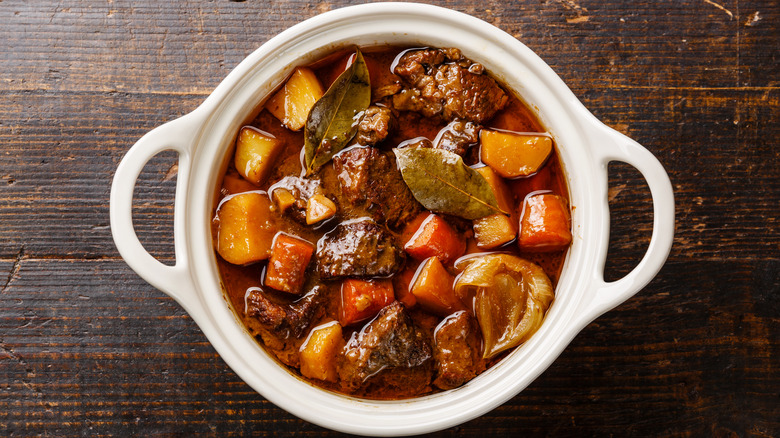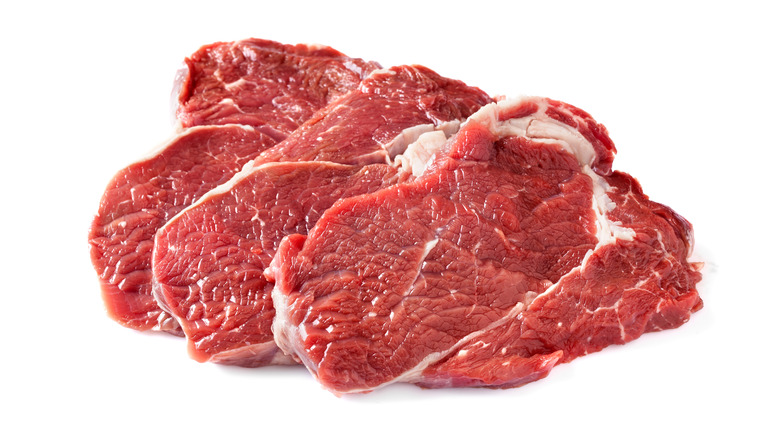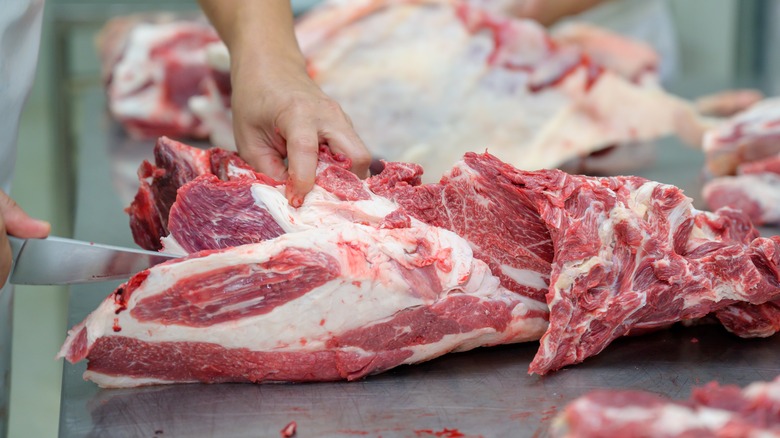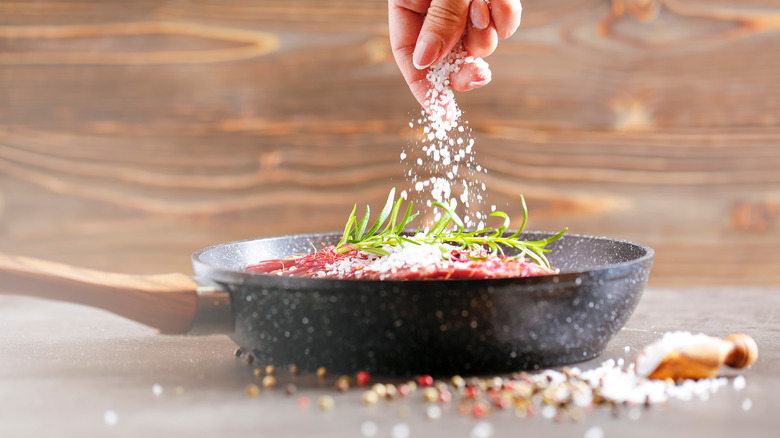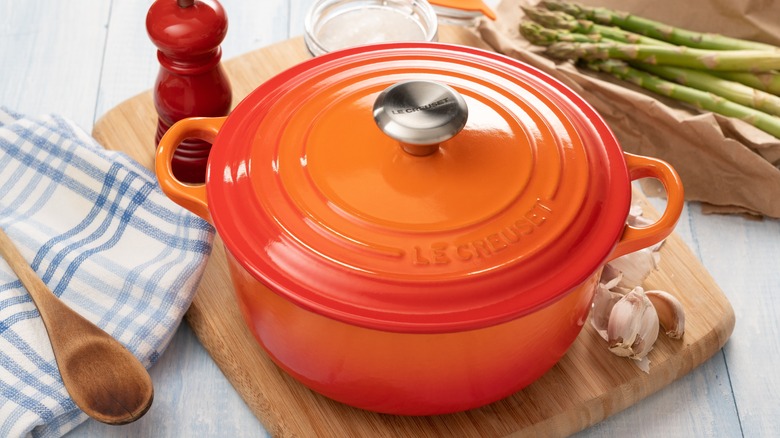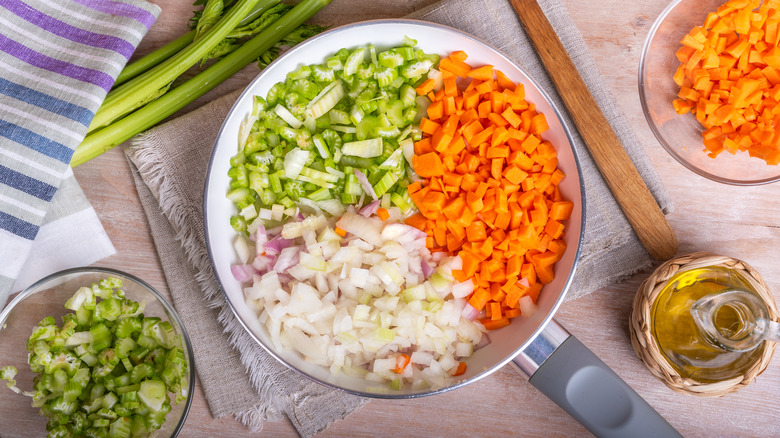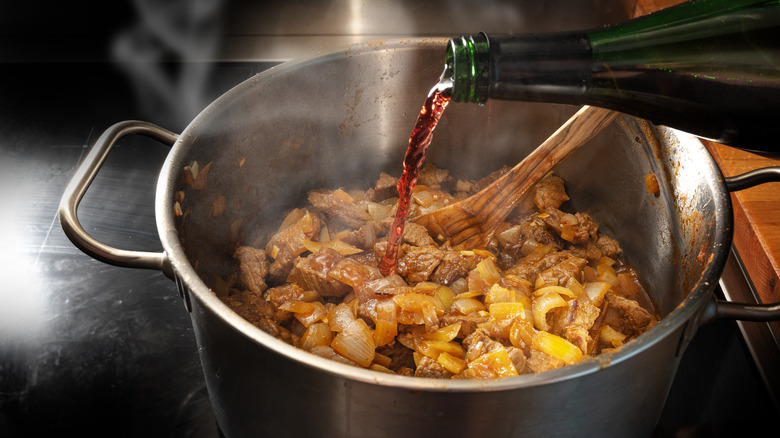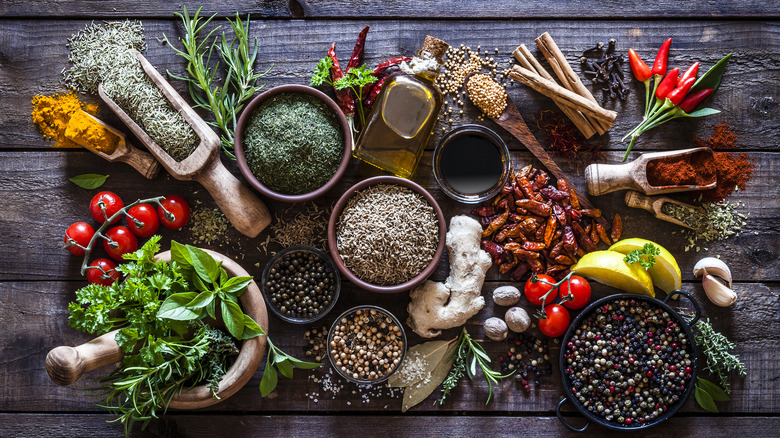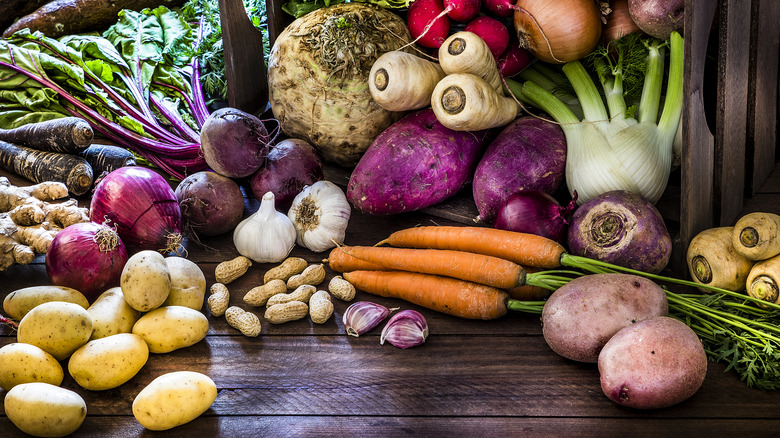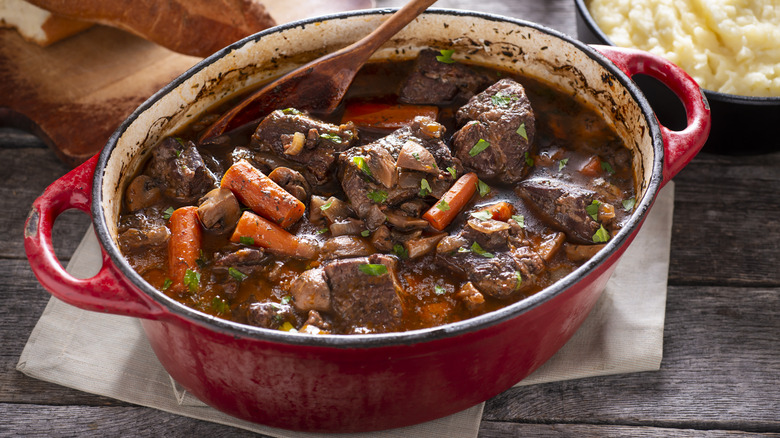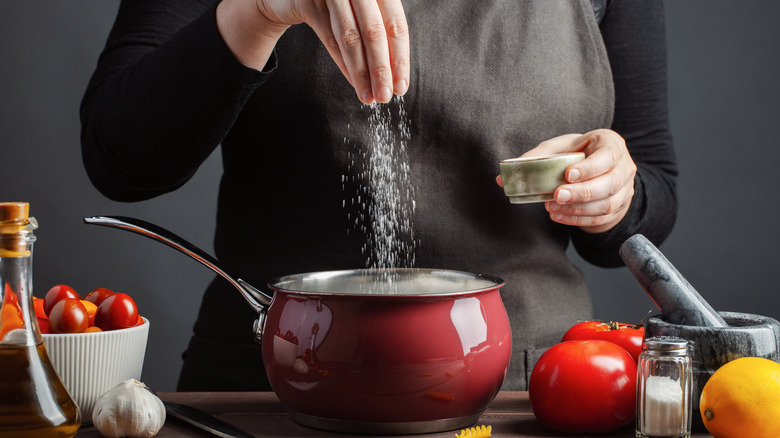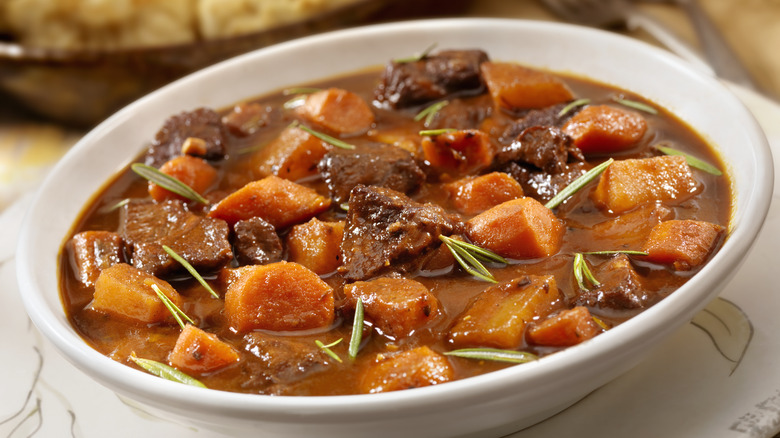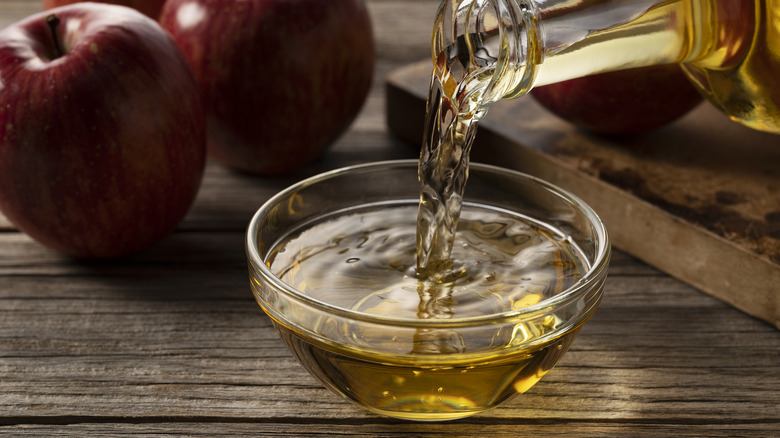14 Tips You Need For Making Beef Stew
Beef stew may just be one of the most comforting meals that's ever existed. It's the culinary equivalent of snuggling up in a warm blanket in front of a crackling fire. Hearty winter vegetables and savory, umami chunks of beef are enrobed in a thick, luscious liquid that heats you up from the inside out.
A stew is made from basic ingredients that are prepared by simmering them for a long time in a liquid (most likely a broth), and although classic American beef stew with potatoes and carrots is perhaps the type of beef stew you're most familiar with, love for this simple, delicious recipe knows no borders. In France, boeuf bourguignon is a favorite winter treat, and in Hungary, beef goulash takes center stage. And a Korean beef stew recipe is a great way to incorporate a new twist on the beloved classic.
So, with all these beef stew recipes floating around, how do you make the best possible pot of stew for yourself when the temperatures start to drop outside? Read on to find out the tips you need to make beef stew.
Choose the right cut of meat
Not all cuts of beef were created equal. While you may be used to seeing names like ribeye and New York strip on the menu at your local steakhouse that doesn't necessarily mean that those are the best cuts when it comes to making beef stew.
When it comes to beef stew, success is all about consistency. Since your stew is going to simmer at a low temperature for several hours, you've got to use a cut of beef that won't fall apart during the cooking process or become tough or dry, but that will soften up just enough to melt in your mouth when it's time to eat. Chuck steak, an underrated cut of steak that's ideal for slow cooking, comes primarily from the neck and shoulder of the cow and has a balance of fat and lean meat that makes it tender after a long, slow simmer in a stew.
It also happens to be celebrity chef Jacques Pepin's absolute favorite cut of beef for stew. Chuck also has a relatively high amount of connective tissue, which adds collagen to the liquid as it cooks, resulting in a nice, rich, hearty beef stew.
Know how to trim and cut your beef
The key to making great beef stew isn't just in the ingredients or the cooking method, it's also in the preparation. After you've picked out the perfect cut of meat for your beef stew, you've got to prepare it to be cooked in the pan before it goes into your pot where it will be simmered. It's crucial at this stage to trim your beef so that you're only left with the very best parts when it comes time to grab a bowl and serve yourself.
Trim the fat from your meat so that your stew doesn't become too heavy and greasy. And for those of you conscious about food waste, fear not, there are clever ways to use steak scraps and trimmings to be sure nothing is wasted. After that, make sure you cut your beef into uniform pieces to ensure they all cook through in roughly the same amount of time. We recommend cutting your beef into 1 to 2-inch cubes.
When you're cutting the beef, also make sure to cut against the grain. That is, you should be cutting perpendicular to the muscle fibers. Cutting steak against the grain is so important because long muscle fibers can become stringy and chewy. Shorter fibers are more likely to cook up nice and tender.
Season and brown your beef
Nothing compares to the meaty, charred exterior of a piece of meat when it's seared at a high temperature. This is due to the Maillard reaction, a chemical reaction that takes place between sugars and amino acids when they're exposed to high temperatures. The process leads to the deep, rich, distinctly umami flavor that we associate with a nice steak. It turns out this is also a crucial step for making maximally tasty beef stew.
Before you start slow cooking your beef, sear it in a pan to trigger the caramelization process and add a nice color and texture to your meat. And you may also want to consider dusting your cubes of beef with seasoned flour before they hit the hot surface of the pan. Seasoning a steak before you sear it will lock a nice, salty flavor into the exterior, and the flour will help to thicken the liquid in the stew. But be sure to drain off the excess liquid before you put the beef into your stock pot or slow cooker so that the stew doesn't become too heavy or greasy.
Simmer in a dutch oven or heavy-bottomed pot
Any chef worth their salt knows that there are certain kitchen items you have to have on hand in order to cook restaurant-quality meals in the comfort of your own home. When it comes to making beef stew, one of the most crucial pieces of kitchen equipment in your arsenal is a Dutch oven or some type of heavy-bottomed pot. These pots may be heavy and cumbersome, but it is their heft that makes preparing beef stew one of the best ways to use your Dutch oven.
Dutch ovens and other heavy-bottomed pots are great at retaining heat, which makes them perfect candidates for cooking stew. You can sear your meat in a Dutch oven before you add the other ingredients to the stew and because the pot retains heat so well, you can be sure that the exterior of the meat will crisp up nicely since it won't cool down when the meat hits the pan. You can also put it in the oven to simmer for a couple of hours and since it has a thick bottom and sides, the heat is distributed evenly throughout the cooking process, leading to a rich, thoroughly flavorful product that will wow your dinner guests.
Infuse with aromatics
There's a lot that goes into giving a beef stew the rich, deep, intense flavor that it's known for. And aromatics, the real workhorses of culinary flavor, are certainly no exception. Aromatics are a category of vegetables and herbs so named because they lend dishes a distinct aroma, which leads to great flavor. Some of the most commonly known aromatics are garlic, onion, celery, and carrots, all of which are often used when preparing beef stew.
The reason aromatics are so important is because when you cook them in oil, it becomes infused with the flavor of the aromatics and it permeates the entire dish. Specifically, when it comes to beef stew, you should cook your aromatics in the fat that's left over after you cook your beef because it already has that meaty, umami flavor that goes great with aromatics. Before you sauté your aromatics, though, be sure to drain off some of the excess fat so that your stew doesn't become too greasy.
Deglaze the pot
Deglazing sounds like a term reserved for the sleek kitchens in fine dining establishments, but it's actually a very simple process that any amateur chef can employ to give their dishes an extra boost of flavor. Deglazing a pan simply means pouring some liquid into the pan after you've sautéed some other ingredients and then scraping the browned bits off the bottom of the pan so that the flavors can be incorporated into the dish.
Specifically, when it comes to beef stew, you should always deglaze your pan because the charred residue left by the beef is packed full of exactly the flavor that you want to add to your stew. On top of that, once you sauté your aromatics there are even more delicious and rich bits in the pan to be harnessed in service of the best beef stew you can possibly make. You can use just about any liquid to deglaze your pan, but we recommend using a red wine, which gives your stew an incredibly complex flavor that pairs well with the richness of the meat.
Select flavorful liquids as a base
The heart of beef stew is the liquid that all of the other ingredients call home. There are plenty of ways to add flavor to the liquid in beef stew, but you've got to make sure to start with the best possible liquids to give your stew a strong, sturdy base on which all the other flavors will rest.
Beef broth is perhaps the most common liquid used in beef stew because it has a strong umami flavor that mirrors the flavor in the meat itself. But you can also use a lighter liquid like chicken broth if you don't want your stew to get too heavy and bogged down with beefy flavor. You can buy broth at the store or make your very own homemade chicken stock from scratch. But it's not just broth that creates a hearty liquid base for beef stew.
Wine is a common addition because it has a deep, distinct flavor that becomes concentrated when the alcohol evaporates during the cooking process, especially when you reduce the wine separately before mixing it with the broth to get rid of all the alcohol. You can get even more adventurous. The salty, tangy taste of fish sauce will add a world of flavor to your stew.
Add herbs and spices
You can't think about creating that distinctly rich, complex flavor of beef stew without considering herbs and spices. There are many components that go into making a great beef stew, but when it comes to selecting your herbs and spices, you want to be sure you're selecting the ones that can stand up to that hearty beef flavor.
The classic approach to adding herbs to a bouef bourguignon recipe (a French beef stew) is to take herbs and tie them together with a piece of butcher's twine or put them in a small satchel and add them to the mixture. This is known as a "bouquet garni," which is French for garnished bouquet. When the stew is done cooking, you can simply lift the herbs out of the stew after they've infused it with all of their delicious, woody flavors.
Rosemary and thyme are two herbs with strong aromas that can yield a heartier beef stew, but the herbs that you use are up to you. Some other herbs that we recommend are bay leaves, parsley, tarragon, and basil. And for spices, you can use black pepper, celery seed, and cayenne pepper for that little extra kick.
Mix in some root vegetables
Beef stew is perfect for dinner in the wintertime. This rich, warm, nourishing dish is bound to warm you right up on a cold night. Because they're so dense and hearty, root vegetables are traditionally eaten during the winter when other more delicate vegetables are no longer available. And root vegetables are perfect for beef stew because they hold their basic shape and structure even after being cooked for a long period of time at low heat.
And it's not only their physical properties that make them great for stew, but their flavors. Popular root veggies like carrots, parsnips, and sweet potatoes contain a bit of sugar, which adds a nice sweetness to round out the flavors of your beef stew. But don't limit yourself; you can throw just about any root vegetable into your stew and it's sure to add some vibrant color and wholesome, earthy flavor that pairs well with the other classic ingredients.
Potatoes and carrots are popular for an old-fashioned beef stew, but daikon radish, celery root, and rutabaga are all great options for a stew that will warm you from the inside out. You generally want to add these veggies about 30 minutes before you're planning on taking off the heat so that they have enough time to cook but don't get too mushy.
Get your cooking time just right
Beef stew should not be on the menu if you're in a rush. One of the key components in beef stew isn't an ingredient, but time. Cooking your stew low and slow is always the way to go when it comes to making a flavorful beef stew that will fill you up in the most comforting way. But exactly how long should you cook beef stew?
The sweet spot is about 2 ½ hours. This gives the meat enough time for its connective tissue to turn into gelatin and thicken up the liquid. If your stew spends too much time simmering, it can strip the pieces of meat of their fat and they can become tough, dry, and difficult to eat. And while your meat is getting too tough, your vegetables can get mushy when they're overcooked and fall apart in the pot before your stew gets served. After two hours or so of simmering, it's a good idea to taste a chunk of beef to see if it still needs a bit more time. But, when you get it just right, the flavors in your stew will meld together and make the whole dish sing.
Taste and adjust as needed
You don't have to helicopter parent your stew, but you should check in every once in a while, particularly toward the end of the process, to make sure all of your flavors are coming together. But bear in mind that the flavor of a stew evolves as it cooks, so after you add all of the ingredients and you're letting your stew simmer, the taste will change as it nears completion.
As we've discussed, spices are a key component to making a great beef stew, but there's a reason you shouldn't taste soup right after adding spices. It takes spices a little while to infuse their flavors into a liquid, so you won't get the full idea of exactly how the stew will turn out unless you give the flavors a bit of time to come together naturally. The same goes for salt. You should salt each component of your stew individually before you cook it, and then later on during the cooking process, taste your stew to determine if it needs more salt. Some of the water in the broth will also evaporate as the stew cooks, leaving a more concentrated, salty flavor behind. So, if your stew doesn't taste quite right at the outset, have a bit of patience and know that you can adjust as needed later down the line.
Thicken the stew
The liquid in a beef stew is the vessel for a lot of its flavor. And it has to be able to deliver that flavor with just the right texture to match. When you think of a hearty, warming beef stew, the liquid isn't thin and watery like soup, but rather thick and slightly more viscous, which gives stew its signature mouthfeel and makes your taste buds feel like they're being wrapped up in a warm sweater.
There are several ways to thicken a beef stew. You can add flour to your meat before you cook it and use potatoes, which will naturally add some starch to your stew, helping it to thicken up. And if your stew seems a bit watery while it's simmering, take the lid off and let some of the water evaporate so that it leaves a more concentrated liquid. You can also make a slurry, which is flour mixed with cold water, and add it to your stew for some extra thickness. Be sure not to add flour directly to your stew because it can clump up, which is not exactly appetizing.
Finish it off with an acidic liquid
Beef stew has a lot of heavy ingredients. It's meant to be a dense and nourishing meal. When you're making something that has a lot of rich, intense flavors, it's a good idea to balance it out with something a little brighter and fresher to provide a nice contrast, which is why you should always include an acidic component in stew. And there are several ideal candidates for brightening up a beef stew that you probably already have in your kitchen.
Worcestershire sauce has an intense, umami flavor that mirrors the taste of the stew, but it also packs an acidic punch. Another great acid to consider is apple cider vinegar, which has an earthy flavor and a slightly sweet, tangy finish that goes well with the bold flavors of beef. Lemon juice is sour, bright, and zesty, which can give your beef stew just what it needs to cut through the fattier taste of the beef. If you're adding lemon juice to stew, however, you want to be sure to add it right at the end. The compounds in lemon juice that give it that nice, bright flavor begin to degrade when heated up too much and end up tasting dull and bitter.
Eat it the next day
While some dishes are best enjoyed fresh off the stove or out of the oven, others are actually better when reheated the next day. Beef stew is a perfect candidate for reheating because the flavors continue to develop even after you take it off the stove. The gelatin in the beef continues to break down after the stew is cooked, which means the liquid continues to thicken and all the ingredients get a chance to marinate.
When it comes to reheating stew leftovers, the microwave is great if you're short on time, but the stove is the way to go. When you're reheating on the stove, it's easy to keep an eye on your stew and adjust as needed. You can add a bit more water or stock if the stew looks a bit too dry and thick. You can also taste it while it's heating up and add more salt if you feel like it's needed. Also, if you've got big chunks of beef or vegetables, you might want to cut them into smaller chunks to make sure they get heated all the way through.
